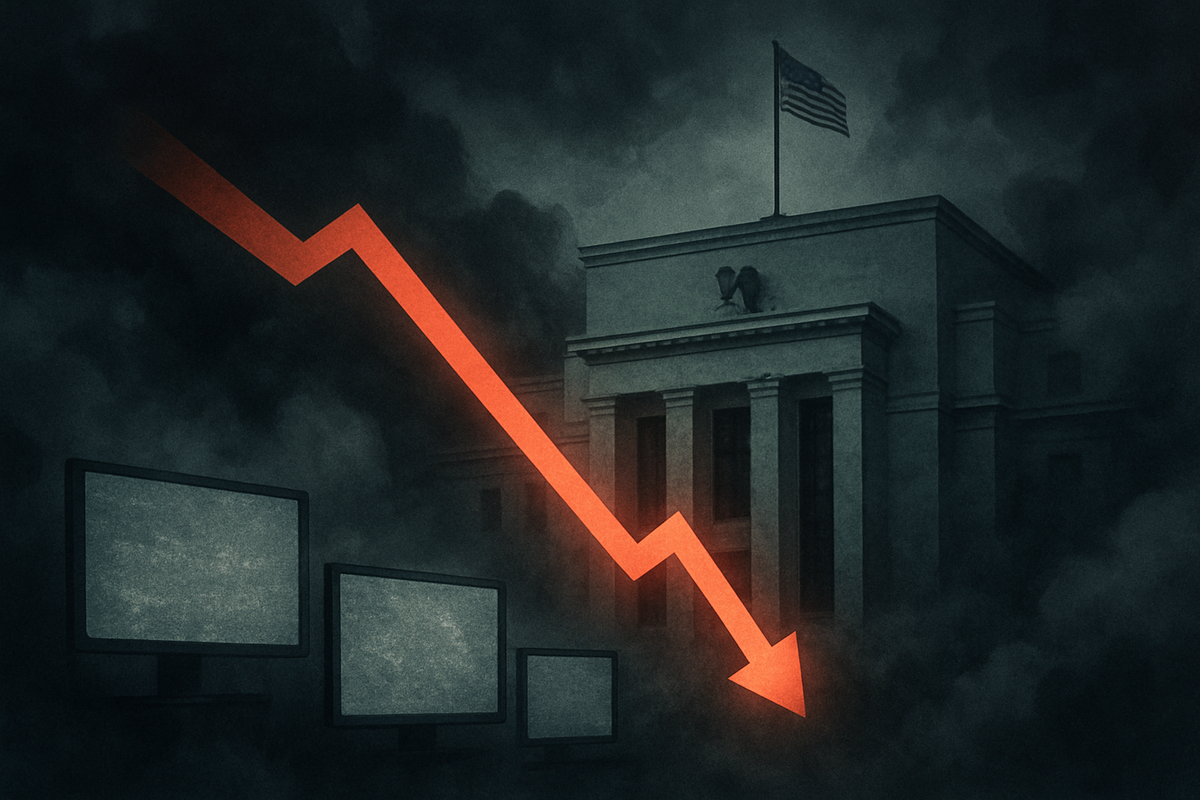
Washington D.C. – October 29, 2025 – In an unprecedented move that sent ripples through global financial markets, the Federal Reserve today announced a 25-basis-point cut to its benchmark federal funds rate, lowering it to a target range of 3.75%-4.00%. This decision, the second such reduction this year, comes amidst a protracted government shutdown that has critically hampered the availability of essential economic data, forcing the central bank to navigate a dense fog of uncertainty. The unusual circumstances surrounding this monetary policy shift have amplified concerns about the true health of the U.S. economy and the Fed's ability to make fully informed decisions.
The immediate implications of this rate cut are multifaceted. While lower borrowing costs are generally expected to stimulate economic activity, boost corporate investment, and encourage consumer spending, the lack of comprehensive data creates a precarious situation. Investors, already anticipating the cut, initially reacted positively, with some reports indicating record highs in Wall Street stocks even before the official announcement. However, the pervasive uncertainty regarding future policy, given the Fed's "flying blind" approach, raises the specter of increased market volatility and potential disappointments if subsequent economic indicators, once available, paint a different picture than what the Fed is currently surmising.
Navigating the Data Vacuum: The Fed's Risky Gamble
The Federal Reserve's decision to cut interest rates today, October 29, 2025, was made under highly unusual and challenging circumstances. The benchmark federal funds rate was lowered by 25 basis points to a target range of 3.75%-4.00%, marking the second such reduction this year. This move, while largely anticipated by market participants, was notable because it occurred during a prolonged government shutdown that began on October 1, 2025. This shutdown has severely disrupted the release of official economic indicators, leaving the Fed without its usual comprehensive and timely data from agencies like the Bureau of Labor Statistics and others responsible for retail sales and consumer spending figures.
The timeline leading up to this moment saw the government shutdown persist for nearly a month, steadily eroding the Fed's data visibility. As the shutdown continued, pressure mounted on the central bank to act, particularly as anecdotal evidence and alternative data sources suggested a softening labor market and persistent, albeit not accelerating, inflation. Key players in this unfolding drama include Federal Reserve Chair Jerome Powell and the members of the Federal Open Market Committee (FOMC), who have been forced to rely on private-sector data, state-level unemployment claims, ADP payroll reports, and insights from the regional Reserve Banks' "Beige Book." This reliance on less authoritative data has reportedly exacerbated existing divisions within the FOMC, highlighting the difficulty of reaching a consensus in a data vacuum.
Initial market reactions were largely positive, with Wall Street stocks showing significant gains even before the official announcement, partly fueled by expectations of the rate cut and strong performances in sectors like artificial intelligence. The bond market saw short-term Treasury yields decline, as expected, making existing bonds with higher yields more attractive. While lower borrowing costs for mortgages, auto loans, and business loans are generally welcomed, the overriding sentiment remains one of heightened uncertainty. Federal Reserve Chair Jerome Powell himself acknowledged the challenges, stating that a potential December rate cut is "not a foregone conclusion" given the divided opinions and the ongoing lack of reliable economic data, hinting at potential future volatility if market expectations for continued easing are not met.
Corporate Winners and Losers in a Low-Rate, High-Uncertainty Environment
The Federal Reserve's decision to cut interest rates, even amidst a data blackout, will undoubtedly create a distinct set of winners and losers across various public companies and sectors. Companies that are heavily reliant on borrowing, or those that benefit from increased consumer spending, are poised to gain, while others, particularly those dependent on higher interest rates for profitability, may face headwinds.
Potential Winners:
- Housing and Real Estate: Lower mortgage rates typically stimulate the housing market. Homebuilders like D.R. Horton (NYSE: DHI) and Lennar Corporation (NYSE: LEN), as well as real estate investment trusts (REITs) focused on residential or commercial properties, could see increased demand and refinancing activity.
- Automotive Industry: Reduced auto loan rates could boost car sales, benefiting manufacturers such as General Motors (NYSE: GM) and Ford Motor Company (NYSE: F), and auto parts suppliers.
- Technology and Growth Stocks: These companies often fund expansion through debt, and lower borrowing costs make growth initiatives more affordable. Tech giants like Apple (NASDAQ: AAPL), Microsoft (NYSE: MSFT), and particularly those in high-growth areas like artificial intelligence, such as NVIDIA (NASDAQ: NVDA), which has seen its market value reach unprecedented levels, could find their valuations further supported by a lower discount rate on future earnings.
- Consumer Discretionary: Companies in this sector, including retailers and leisure industries, could benefit from consumers having more disposable income due to lower debt service costs.
- Companies with High Debt Loads: Businesses carrying significant debt will see their interest expenses decrease, improving profitability and cash flow.
Potential Losers:
- Banks and Financial Institutions: While some aspects, like increased loan demand, could be positive, a sustained period of lower interest rates can compress net interest margins (NIMs), which is the difference between what banks earn on loans and pay on deposits. Major banks like JPMorgan Chase (NYSE: JPM), Bank of America (NYSE: BAC), and Wells Fargo (NYSE: WFC) might see pressure on their profitability.
- Insurance Companies: Insurers often invest premiums in fixed-income securities. Lower interest rates reduce the returns on these investments, impacting their investment income and overall profitability.
- Savers and Fixed Income Investors: Individuals and institutions relying on interest income from savings accounts, money market funds, and certain bonds will see reduced returns, potentially pushing them into riskier assets in search of yield.
- Companies with Strong Cash Positions: While not necessarily "losers," companies with large cash reserves that typically earn interest on those holdings will see their investment income diminish.
The unusual aspect of this rate cut – the absence of full economic data – introduces an additional layer of risk. Companies that make strategic decisions based on assumptions about sustained low rates might be caught off guard if the Fed is forced to reverse course quickly once more complete data becomes available, leading to potential misallocations of capital and unexpected market shifts. This uncertainty could make it challenging for companies to accurately forecast demand and plan for future investments.
Broader Significance: A Precedent in the Fog
The Federal Reserve's rate cut on October 29, 2025, during a government shutdown and a resulting data blackout, represents a moment of profound broader significance for the financial markets and economic policy. This event sets a potentially troubling precedent, demonstrating the Fed's willingness to act on monetary policy with incomplete information, a scenario that underscores the critical importance of timely and accurate government economic data. It raises questions about the robustness of economic governance when one of its pillars is forced to operate in a "fog."
This decision fits into broader industry trends of central banks globally grappling with persistent inflationary pressures, albeit moderating, and the delicate balance required to support economic growth without reigniting price surges. The Fed's move, despite the data vacuum, suggests a strong underlying concern for economic growth and employment, possibly indicating a belief that the economy is more fragile than headline figures might suggest if all data were available. Potential ripple effects on competitors and partners are significant; other central banks might feel pressure to follow suit if the U.S. economy shows signs of further slowing, or they might watch cautiously, wary of making policy decisions without full clarity. The international bond markets and currency markets will also react, with a weaker dollar potentially benefiting U.S. exporters but making imports more expensive.
Regulatory and policy implications are substantial. This episode highlights the vulnerability of independent institutions like the Federal Reserve to political gridlock. It may spark renewed calls for mechanisms to ensure the continuous flow of critical economic data, even during government shutdowns, or for a re-evaluation of how the Fed communicates its decision-making process when operating under such constraints. Historically, there are few direct precedents for a Fed rate cut during a prolonged data blackout of this magnitude. While the Fed has faced periods of limited data or economic uncertainty before, the current situation, where the source of the data is deliberately withheld, is relatively unique. Comparisons might be drawn to periods of extreme crisis where swift action was deemed necessary despite imperfect information, but the current context lacks the immediate, acute shock of a 2008-style financial meltdown, making the preemptive nature of this cut more notable. The decision could be seen as a calculated risk, prioritizing the prevention of a deeper economic downturn over the precision afforded by complete data.
The Path Ahead: Navigating Uncharted Waters
The Federal Reserve's rate cut marks the beginning, not the end, of a period of heightened scrutiny and uncertainty for the financial markets. In the short-term, investors will be closely watching for any signs of the government shutdown's resolution, as the resumption of economic data releases will be crucial for clarifying the true state of the economy. Any initial positive market reactions from the rate cut could be short-lived if the incoming data reveals a weaker economic picture than the Fed currently assumes. Companies will need to remain agile, with potential strategic pivots required to adapt to rapidly changing economic signals. Those that have capitalized on lower borrowing costs for expansion might need to reassess their debt strategies if the economic outlook deteriorates or if the Fed's future actions diverge from market expectations.
Looking further ahead, the long-term possibilities are diverse and depend heavily on the duration of the government shutdown and the subsequent economic data. If the shutdown resolves quickly and data confirms a robust economy, the Fed might find itself in a difficult position, potentially having to reverse course or slow future easing, which could trigger market volatility. Conversely, if the data confirms a significant slowdown, further rate cuts could be on the horizon, potentially leading to a more prolonged period of low interest rates. Market opportunities may emerge for investors willing to take on calculated risks in sectors that traditionally outperform in low-rate environments, such as high-growth technology or dividend-paying stocks. However, challenges will persist for traditional income-generating assets and financial institutions.
Potential scenarios and outcomes include:
- "Soft Landing" Success: The shutdown ends, data confirms a mild slowdown, and the Fed's preemptive cut helps the economy avoid a recession. Markets stabilize, and confidence slowly returns.
- "Stagflationary Drift": The shutdown persists, or data reveals a combination of weak growth and sticky inflation. The Fed faces a policy dilemma, leading to prolonged market uncertainty and underperformance.
- "Policy Error" Reversal: New data, once available, contradicts the Fed's current assessment, forcing a rapid shift in monetary policy, potentially causing significant market corrections. Companies should focus on maintaining strong balance sheets, diversifying revenue streams, and hedging against interest rate fluctuations. The coming months will be a test of resilience for both policymakers and market participants.
A Risky Bet with Lasting Implications
The Federal Reserve's decision to cut interest rates on October 29, 2025, amidst a government shutdown and an unprecedented data vacuum, represents a high-stakes gamble on the U.S. economy. The key takeaway is the extraordinary circumstance under which this monetary policy action was taken, forcing the Fed to rely on incomplete information and alternative data sources. This move underscores the central bank's perceived urgency to support economic growth and employment, even at the risk of making decisions without its usual comprehensive economic compass. While initial market reactions were cautiously positive, the underlying uncertainty about the true state of the economy and the Fed's future path remains a dominant theme.
Moving forward, the market will be exceptionally sensitive to any developments regarding the government shutdown and, crucially, the eventual release of delayed economic data. This event highlights the critical interplay between fiscal policy (government operations) and monetary policy (Federal Reserve actions), demonstrating how disruptions in one can profoundly complicate the other. The lasting impact of this decision will depend on whether the Fed's preemptive strike successfully mitigates a potential downturn or if the lack of data leads to a misjudgment that requires swift correction. This episode serves as a powerful reminder of the fragility of economic forecasting and policy-making when fundamental information is absent.
Investors should watch for several key indicators in the coming months: the resolution of the government shutdown and the subsequent deluge of economic data, any shifts in the Federal Reserve's forward guidance, and the performance of interest-rate sensitive sectors. Companies with robust balance sheets and adaptable business models are likely to navigate this period of uncertainty more effectively. Ultimately, this rate cut in the fog is a testament to the Fed's commitment to its dual mandate, but it also casts a long shadow of doubt on the precision and efficacy of monetary policy when critical economic signals are obscured.
This content is intended for informational purposes only and is not financial advice





